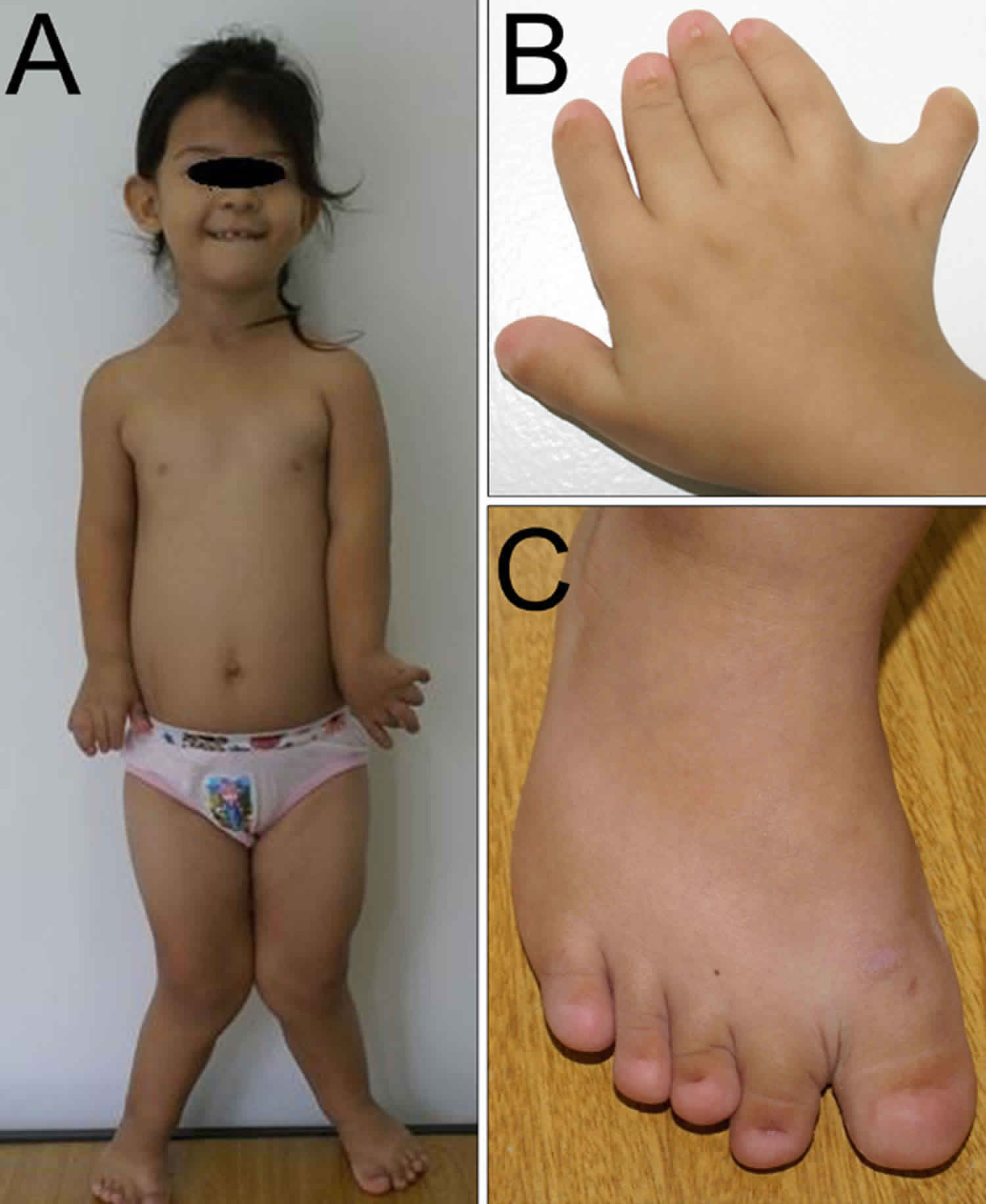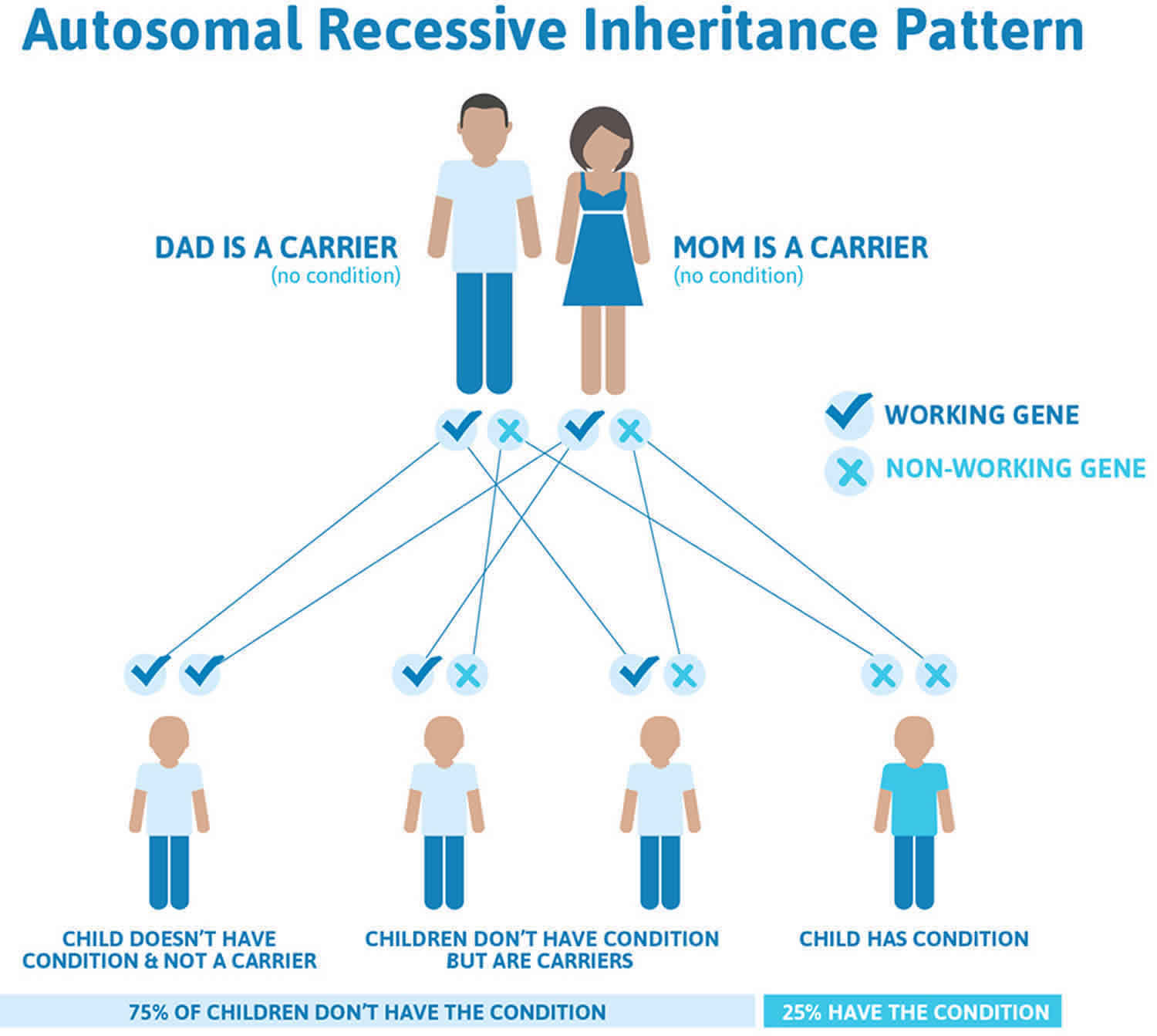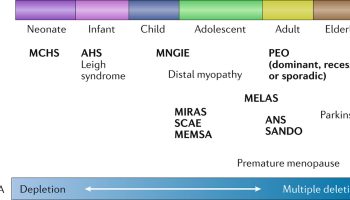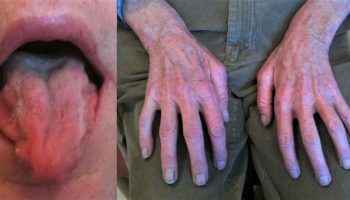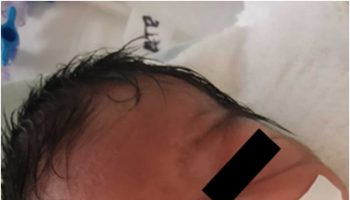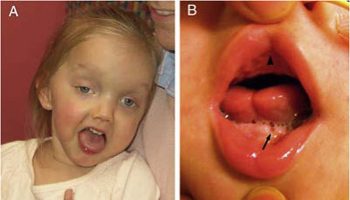Ellis-van Creveld syndrome
Ellis-van Creveld syndrome is an inherited disorder of bone growth that results in very short stature (dwarfism) 1. People with Ellis-van Creveld syndrome have short stature particularly short forearms and lower legs and a narrow chest with short ribs. Ellis-van Creveld syndrome is also characterized by the presence of extra fingers and toes (polydactyly), missing and/or malformed fingernails and toenails, and dental abnormalities. More than half of affected individuals are born with a heart defect, which can cause serious or life-threatening health problems.
More than half of people affected by Ellis-van Creveld syndrome have changes (mutations) in the EVC or EVC2 genes; the cause of the remaining cases is unknown. Ellis-van Creveld syndrome is inherited in an autosomal recessive manner. The features of Ellis-van Creveld syndrome overlap with those of another, milder condition called Weyers acrofacial dysostosis 1. Like Ellis-van Creveld syndrome, Weyers acrofacial dysostosis involves tooth and nail abnormalities, although affected individuals have less pronounced short stature and typically do not have heart defects. The two conditions are caused by mutations in the same genes.
In most parts of the world, Ellis-van Creveld syndrome occurs in 1 in 60,000 to 200,000 newborns 1. It is difficult to estimate the exact prevalence because the disorder is very rare in the general population. Ellis-van Creveld syndrome is much more common in the Old Order Amish population of Lancaster County, Pennsylvania, and in the indigenous (native) population of Western Australia.
Ellis-van Creveld syndrome treatment is based on the signs and symptoms present in each person.
Ellis-van Creveld syndrome causes
Ellis-van Creveld syndrome can be caused by mutations in the EVC or EVC2 gene. Little is known about the function of these genes, although they appear to play important roles in cell-to-cell signaling during development. In particular, the proteins produced from the EVC and EVC2 genes are thought to help regulate the Sonic Hedgehog signaling pathway. This pathway plays roles in cell growth, cell specialization, and the normal shaping (patterning) of many parts of the body.
The mutations that cause Ellis-van Creveld syndrome result in the production of an abnormally small, nonfunctional version of the EVC or EVC2 protein. It is unclear how the defective proteins lead to the specific signs and symptoms of this condition. Studies suggest that they prevent normal Sonic Hedgehog signaling in the developing embryo, disrupting the formation and growth of the bones, teeth, and other parts of the body.
Together, mutations in the EVC and EVC2 genes account for more than half of all cases of Ellis-van Creveld syndrome. The cause of the remaining cases is unknown.
Ellis-van Creveld syndrome inheritance pattern
Ellis-van Creveld syndrome is inherited in an autosomal recessive pattern, which means both copies of the gene in each cell have mutations. The parents of an individual with an autosomal recessive condition each carry one copy of the mutated gene, but they typically do not show signs and symptoms of the condition.
It is rare to see any history of autosomal recessive conditions within a family because if someone is a carrier for one of these conditions, they would have to have a child with someone who is also a carrier for the same condition. Autosomal recessive conditions are individually pretty rare, so the chance that you and your partner are carriers for the same recessive genetic condition are likely low. Even if both partners are a carrier for the same condition, there is only a 25% chance that they will both pass down the non-working copy of the gene to the baby, thus causing a genetic condition. This chance is the same with each pregnancy, no matter how many children they have with or without the condition.
- If both partners are carriers of the same abnormal gene, they may pass on either their normal gene or their abnormal gene to their child. This occurs randomly.
- Each child of parents who both carry the same abnormal gene therefore has a 25% (1 in 4) chance of inheriting a abnormal gene from both parents and being affected by the condition.
- This also means that there is a 75% ( 3 in 4) chance that a child will not be affected by the condition. This chance remains the same in every pregnancy and is the same for boys or girls.
- There is also a 50% (2 in 4) chance that the child will inherit just one copy of the abnormal gene from a parent. If this happens, then they will be healthy carriers like their parents.
- Lastly, there is a 25% (1 in 4) chance that the child will inherit both normal copies of the gene. In this case the child will not have the condition, and will not be a carrier.
These possible outcomes occur randomly. The chance remains the same in every pregnancy and is the same for boys and girls.
Figure 1 illustrates autosomal recessive inheritance. The example below shows what happens when both dad and mum is a carrier of the abnormal gene, there is only a 25% chance that they will both pass down the abnormal gene to the baby, thus causing a genetic condition.
Figure 1. Ellis-van Creveld syndrome autosomal recessive inheritance pattern
People with specific questions about genetic risks or genetic testing for themselves or family members should speak with a genetics professional.
Resources for locating a genetics professional in your community are available online:
- The National Society of Genetic Counselors (https://www.findageneticcounselor.com/) offers a searchable directory of genetic counselors in the United States and Canada. You can search by location, name, area of practice/specialization, and/or ZIP Code.
- The American Board of Genetic Counseling (https://www.abgc.net/about-genetic-counseling/find-a-certified-counselor/) provides a searchable directory of certified genetic counselors worldwide. You can search by practice area, name, organization, or location.
- The Canadian Association of Genetic Counselors (https://www.cagc-accg.ca/index.php?page=225) has a searchable directory of genetic counselors in Canada. You can search by name, distance from an address, province, or services.
- The American College of Medical Genetics and Genomics (http://www.acmg.net/ACMG/Genetic_Services_Directory_Search.aspx) has a searchable database of medical genetics clinic services in the United States.
Ellis-van Creveld syndrome symptoms
Individuals with Ellis-Van Creveld syndrome typically have arms and legs that are abnormally short while the head and trunk are normal. Extra fingers (polydactyly) are present in all patients with this condition and both hands are usually affected. Ectodermal abnormalities include abnormal development of hair, nails and teeth.
More than fifty percent of the patients with Ellis-Van Creveld syndrome are born with malformations of the heart. The most common heart defect is an abnormal opening in the wall between the two upper heart chambers (atrial septal defect). Other types of heart defects have also been reported including ventricular septal defects and patent ductus arteriosis.
Some boys with this condition have been described with undescended testicles (cryptorchidism) or an abnormally located opening of the urine canal in the penis (epispadias). Abnormalities in the chest wall, spine and respiratory system have also been reported.
Ellis-van Creveld syndrome diagnosis
Ellis-Van-Creveld syndrome is diagnosed by the observation of short stature, slow growth, skeletal abnormalities determined by imaging techniques and sometimes teeth present at birth (natal teeth). Molecular genetic testing for the EVC and EVC2 genes is available on a research basis only. Prenatal diagnosis is possible by ultrasound.
Ellis-van Creveld syndrome treatment
It is often necessary to treat respiratory distress shortly after birth that results from a narrow chest and/or heart failure. Natal teeth should be removed because they can interfere with feeding.
The treatment of Ellis-Van Creveld syndrome is directed toward the specific symptoms that are apparent in each individual. Such treatment may require the coordinated efforts of a team of medical professionals, such as pediatricians, surgeons, cardiologists, dentists, pulmonologists, orthopedists, urologists, physical and occupational therapists and/or other health care professionals.
Genetic counseling is recommended for affected individuals and their families.
Ellis-van Creveld syndrome prognosis
A poor prognosis is declared in the neonatal period. Congenital cardiac anomalies and thoracic dysplasia (with a narrow chest wall) causing severe respiratory compromise are leading causes of death at this time.
Patients who survive infancy with non–life-threatening pulmonary or cardiac conditions are expected to have a normal life span. Final adult skeletal height has been difficult to predict. Publications have cited an adult height range of 119 cm (3’11”) to 161 cm (5’3″) 2.
Developmentally, most patients have normal intelligence 3. Case reports have cited patients with associated brain malformations (Dandy-Walker anomaly, hydrocephalus, cerebral heterotopias) and developmental delay 4.
- Ellis-van Creveld syndrome. https://ghr.nlm.nih.gov/condition/ellis-van-creveld-syndrome[↩][↩][↩]
- da Silva EO, Janovitz D, de Albuquerque SC. Ellis-van Creveld syndrome: report of 15 cases in an inbred kindred. J Med Genet. 1980 Oct. 17 (5):349-56.[↩]
- Baujat G, Le Merrer M. Ellis-van Creveld syndrome. Orphanet J Rare Dis. 2007 Jun 4. 2:27.[↩]
- ELLIS-VAN CREVELD SYNDROME; EVC. https://www.omim.org/entry/225500[↩]
